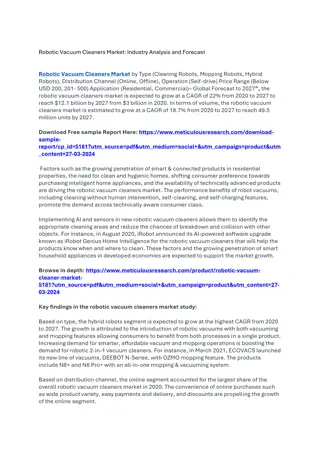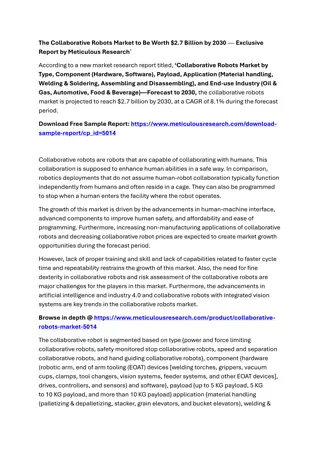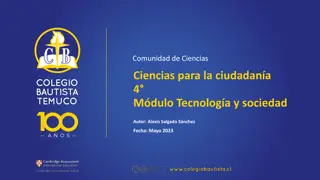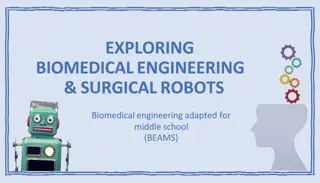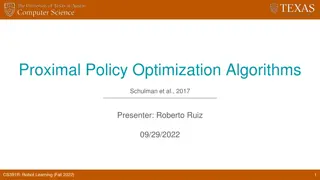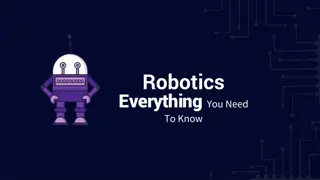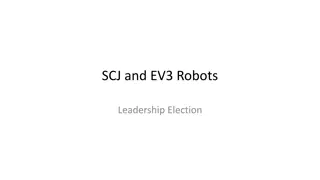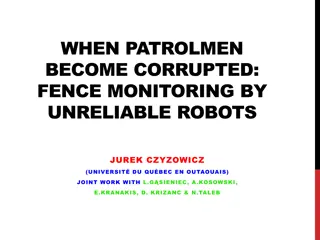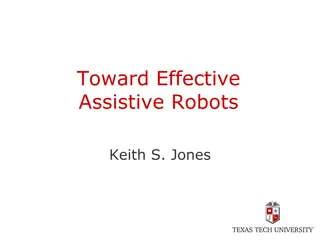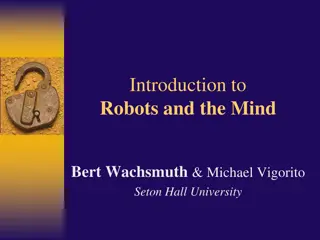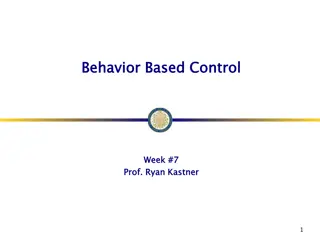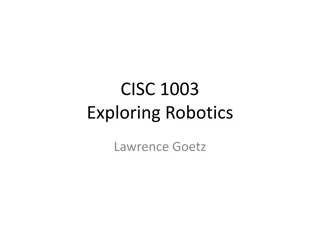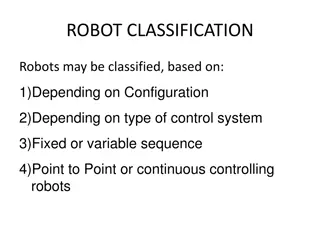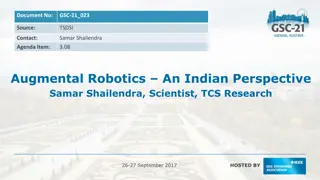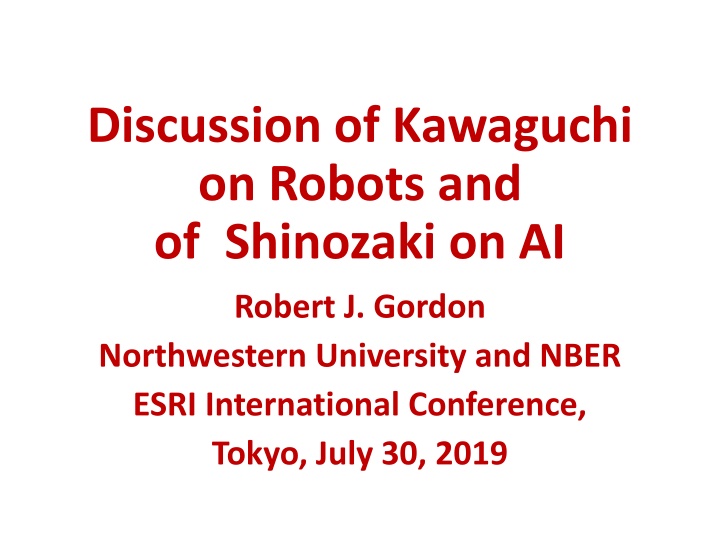
Evolution and Impact of Robots and AI in Economic Research
Explore the discussion on robots and AI in economic research, debunking the myth of a rapid industrial revolution and emphasizing slow evolution. Discover insights on job automation, productivity growth, and the historical context of robotics and AI.
Download Presentation

Please find below an Image/Link to download the presentation.
The content on the website is provided AS IS for your information and personal use only. It may not be sold, licensed, or shared on other websites without obtaining consent from the author. If you encounter any issues during the download, it is possible that the publisher has removed the file from their server.
You are allowed to download the files provided on this website for personal or commercial use, subject to the condition that they are used lawfully. All files are the property of their respective owners.
The content on the website is provided AS IS for your information and personal use only. It may not be sold, licensed, or shared on other websites without obtaining consent from the author.
E N D
Presentation Transcript
Discussion of Kawaguchi on Robots and of Shinozaki on AI Robert J. Gordon Northwestern University and NBER ESRI International Conference, Tokyo, July 30, 2019
Background for the Discussion Economic research on robots and AI is growing faster than their influence on the economy Techno-optimists have predicted a 4th industrial revolution starting tomorrow as robots and AI replace human workers No revolution, just a slow evolution Most important fact about robots is their unimportance: IFR total 2017 worldwide investment in robots outside China: $11b Nonres fixed investment in US $2,900b
Robots and AI Are Old News First industrial robot installed by GM in 1961. NBER group viewed U.S. auto factories in 1995 where robots were for welding and painting Artificial intelligence (AI) is not new: has already been replacing jobs for at least 20 years predominant uses of big data analytics are in marketing, a zero-sum game Evolutionary change: use of AI for voice recognition, language translation, radiology diagnosis, legal searches
Frey and Osborne (2013): Automation Destroys 47% of Jobs Frey-Osborne 2013 is cited by both papers Prediction: 47% of U.S. jobs will be replaced by computerization by 2033 In contrast U.S. economy has created 20m jobs since 2010. We re 1/3 through F-O interval. Their forecasts for computer replacement of jobs (they do this for 700 jobs): Bank tellers (98%), restaurant cooks (96%), refuse collectors (93%), retail salespersons (92%), construction labor (88%), real estate sales agents (86%) ================airline pilots (55%)!
ATM Machines and Bank Teller Jobs
Brick and Mortar Retail Job Losses versus e-Commerce Job Gains
If Robots and AI Kill Jobs, They Must Raise Productivity Growth We can indirectly examine the topic of today s papers by looking at trends in productivity growth We ll look at productivity growth in Total U.S. economy U.S. manufacturing Then robot penetration by country, contrast between South Korea and U.S. South Korea should have accelerating manufacturing productivity growth, esp. relative to U.S. Japan: manufacturing productivity growth compared to U.S.
U.S. Total Economy Productivity Growth, Kalman Trend, 1950-2018 Kalman Trends for US Productivity Growth, Business Sector, 1950-2018 5 4.5 4 3.5 3 2.5 Labor Productivity 2 1.5 1 0.5 0 1950 1955 1960 1965 1970 1975 1980 1985 1990 1995 2000 2005 2010 2015
Contrast Total Economy with Manufacturing, 1950-2018 Kalman Trends for US Productivity Growth, Business Sector vs Manufacturing, 1950- 2018 5 4.5 4 Manu Labor Productivity 3.5 3 2.5 2 1.5 Labor Productivity 1 0.5 0 1950 1955 1960 1965 1970 1975 1980 1985 1990 1995 2000 2005 2010 2015
Growth in U.S. Manufacturing Capacity, 1953-2019 Annual Capacity Growth in US Manufacturing, 1953-2019, Five Year Moving Average 7 6 5 4 3 2 1 0 -1 1953 1958 1963 1968 1973 1978 1983 1988 1993 1998 2003 2008 2013 2018
Level of U.S. Manufacturing Capacity, 1948-2019 Level of US Manufacturing Capacity, 1948-2018 150 139.54 138.02 120 90 60 30 0 1948 1953 1958 1963 1968 1973 1978 1983 1988 1993 1998 2003 2008 2013 2018
Level of Computer Capital Stock in US Manufacturing, 1987-2017 Level of Computer Capital Stock in US MFG, 1988-2017, billion of chained 2012 dollars 120 100 80 60 40 20 0 1987 1992 1997 2002 2007 2012 2017
Robots per 10,000 Employees, Five Countries Industrial Robot Density, Units per 10,000 Manufacturing Employees, 2017 800 710 700 600 World Average: 85 Europe Average: 196 500 400 322 308 300 200 200 97 100 0 Korea Germany Japan United States China
Robot Ratio, U.S. vs. South Korea, 1993-2014 Ratio of Robots to Total Employment, US vs Korea, 1993-2014 20 15 10 5 0 1993 1995 1997 1999 2001 2003 2005 2007 2009 2011 2013 2015 Korea US
Manufacturing Productivity Growth, U.S. vs. S.K., 1955-2017 5-Year Moving Average of Manufacturing Productivity Growth, US vs Korea, 1955- 2017 12 10 8 6 4 2 0 1955 1960 1965 1970 1975 1980 1985 1990 1995 2000 2005 2010 2015 -2 United States Korea
U.S. vs. Japan, 1955-2017 Average Growth Rate Identical, 1978-2017! 5-Year Moving Average of Manufacturing Productivity Growth, US vs Japan, 1955- 2017 12 10 8 6 4 2 0 1955 1960 1965 1970 1975 1980 1985 1990 1995 2000 2005 2010 2015 -2 United States Japan
Do Robots Boost Productivity? Transport Equipment 1987-2017 US Transportation Euipment Manufacturing, Annualized Labor Productivity Growth, 1987-2017 1987-1996 1.89 1996-2004 4.44 2004-2012 2.67 2012-2017 -0.57 -1 0 1 2 3 4 5
The Kawaguchi Paper on Robots Important contribution to make CZ the unit of observation Detailed data on 300+ CZ s employment, population, age, sex, education, industry A major achievement creating the data The question is the effect of robots on these variables by CZ, but no data on robots in each CZ
Projecting CZ Robot Data from Industry Robot Data 2002-17 robot growth in a CZ is set equal to the industry share in that CZ times aggregate robot growth in that industry Transport equipment has far more robot growth than any other industry Endogeneity problem Demand shock for an industry raises employment and robot growth Solution: substitute German robot growth by industry as an IV
Surprising Results Faster robot growth in a CZ raises employment, boosts population even more, thus reduces empl/pop ratio Results overturn previous research Frey-Osborne on job losses from automation Acemoglu-Restrepo on 6 jobs lost per robot Explanation for greater rise in population? Local multiplier effect Gain in jobs in service sector
Comments on Results Very high correlation between Japan and Germany in industrial distribution of robots Thus IV solution to endogeneity problem is unconvincing Figure 6, empl/pop is almost uncorrelated with robots, regression line almost flat Results depend on a few observations of CZ s with high share of transport equipment Figures 7 and 8, both empl and pop are positively correlated with robots. Why?
Alternative Explanation Robot variable (change per 1000 employees 2002-2017) very skewed. Transport equipment +19 13 industries -3 to +0.3 Remaining 6 industries -12 to -4 So result that high robot change raises empl and pop amounts to saying CZ s intensive in motor transport had above- average growth in empl and pop Many CZ s dominated by other industries had population decline. The Japan Rust Belt
Shinozaki Paper on AI Paper studies effects of AI on hours, employment, and three components of NRTI (reminds me of airport code NRT) Results show very slight (4%) reduction in hours/employee in group with AI relative to group without AI Surprisingly, AI which would be expected to replace routine tasks raised repetition task NRTI1
Measurement Issues Unlike the robot paper, this paper does not use government or industry data It is based on their survey of employees and managers But results on hours/employee and task intensity are reported only for the employee survey Primary emphasis on change in hours per employee reported by employees.
Measurement of AI, Treatment vs. Control Groups The Kawaguchi robot paper found a spectrum of robot change intensity This paper has no spectrum, either AI Added Last 5 Years or No AI No consideration of a third category, AI already present 5 years ago so no change No discussion of what qualifies as AI Minority AI, 212 / 2266 observations
Difference-in-Difference Methodology Treatment group is compared to control group In robot paper we learned that firms with large robot change were different also because they made motor vehicles Here there is no information on what kinds of firms are in AI group compared to no-AI group They may be different in important ways related to employment growth
The Measurement of Hours Employees are asked for change in hours compared to 5 years ago This concept is hours/employee not aggregate hours. Do salaried employees work fixed hours How can an employee remember how many hours worked 5 years ago? Substitution from AI we re concerned with total hours and employment, not hours/employee Survey: only employees who remained. Departing employees excluded, minimizes loss New employees have no recall of past hours
Employee Survey vs. Manager Survey Preferable to use manager survey Can distinguish change in aggregate employment, hours/employee, and aggregate hours Managers may have records of employee hours that employees cannot recall Managers know how many employees have departed, total count of employees compared to five years ago Note conflicting results, AI reduces hours/employee but increases employment
Task Intensity Measures NRTI1 = repetition NRTI2 = decision making NRTI3 = communication Can all tasks be accurately characterized by these three categories? What about other tasks? Major part of paper is devoted to estimating AI effects on changes in hours by task. Same question: Can employees remember 5 years ago? Surprise! repetition task hours increased by AI, no significant AI effect on other tasks
Detailed Results by Five Occupational Categories Significant reduction in hours/employee only for two of five occupations included No results reported for employment Significant increase in repetition NRTI1 for only two of five occupations included Significant increase in decision making NRTI2 for only one of five occupations included No significant effect for communication NRTI3 in any occupation
Authors Conclusions Reduction in hours/employee and increase in employment reveals presence of both substitution and complementarity This set of conflicting results can be questioned because of the defects in measuring hours/employee from an employee survey Increase in repetition task True for only 2/5 occupations Even more severe memory problems of what tasks were performed 5 years ago Future Research: survey managers not employees


